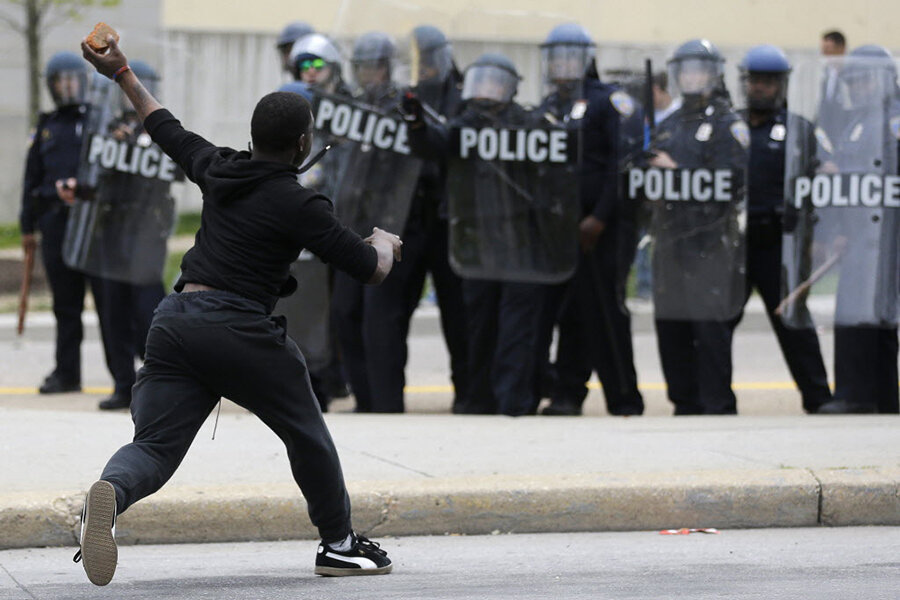Why did Baltimore riots prompt 'Blue Alert' in Los Angeles?
Loading...
| Los Angeles
The Los Angeles Police Department has ordered officers to ride in pairs after the Baltimore police sent out a coast-to-coast “Blue Alert” warning of what they call “a credible threat” against all police nationwide.
As tension in Baltimore has escalated over the death of Freddie Gray, who suffered a fatal spinal cord injury while in police custody, the Baltimore Police Department said its Criminal Intelligence Unit had obtained information indicating "members of various gangs including the Black Guerilla Family, Bloods, and Crips have entered into a partnership to 'take out' law enforcement officers."
At least 15 police officers were injured in the violence Monday night as Baltimore protesters took to the streets, shattering car windows, torching buildings and police cruisers, and throwing bricks at officers.
"The Los Angeles Police Department always has a two man car responding to radio calls," a spokesman for the LAPD said in an email statement to the Montior. "At times we do have one officer in a patrol vehicle only responding to take reports. Due to the Blue Alert issued by Baltimore PD, LAPD took precautionary measures to keep officers safe and be partnered up at all times. Currently the City of Los Angeles has not received any threats."
To many familiar with criminal justice issues, the decision to pair all officers up is just common sense. But others question whether the LAPD’s decision to do so sends the right message to gangs and other community members in this particular instance.
“It’s an embarrassment that an Instagram picture and a truce between gangs gets police all the way across the country to reform their practices,” says Rory Kramer, a professor in Villanova University’s Department of Sociology and Criminology who specializes in how segregated neighborhoods are formed in urban areas. “It’s sad that the reform only serves to promote and reinforce an antagonistic view of the community from the police.”
Dr. Kramer says the pairing of officers is “another example of police creating a false narrative of armed, warring gangs to justify an unnecessary and violent standard code of conduct. It creates a damaging moral panic.”
L.A. County Sheriff Jim McDonnell and religious leaders held a news conference Monday to call for peace.
“We respect the right of people to exercise their First Amendment rights peacefully, but we can’t condone violence and lawlessness of any kind,” he told reporters.
A protest against police brutality in South Los Angeles resulted in six arrests Monday night.
Najee Ali, a well-known community activist and executive director of Project Islamic H.O.P.E. in Los Angeles suggests that the LAPD is using the incident to justify a bigger show of force.
“There has been no evidence of any threat to law enforcement in L.A. county ... by gangs or by community members, and [LAPD] Chief Beck shouldn’t react to a threat to law enforcement which is yet not proven, 3,000 miles away,” says Ms. Ali, who is planning a rally in support of Baltimore residents this Thursday.
But several analysts do say that two officers in a car is valuable for all kinds of reasons.
“Anything that reduces officers’ sense of being underside is a good thing” says Joel Jacobsen, an assistant attorney general in New Mexico.
“Obviously, two sets of eyes will be better at detecting threats, so it improves officers' safety. But also, being alone in the middle of the night and feeling vulnerable among hostile civilians cannot be conducive to good decision-making. Having someone else to rely on in a tight corner should help to keep an officer who feels threatened stay calm,” says Mr. Jacobsen. “So I see it as a benefit not just to the officers but to the civilians they come into contact with.”
Solitary patrols have become the nationwide norm, because it stretches the appearance of police protection further, says Tod Burke, who teaches criminal justice at Radford University in Virginia. But in large cities, having two per car is less expensive, he adds.
“Half the police agencies in the country have fewer than 25 officers but in big cities which have thousands of officers it makes much more sense to have two per car because you don’t have to pay for more cruisers,” Professor Burke says.
Still, critics worry that the LAPD is adopting this strategy for the wrong reason.
“I don’t think any police department should be influenced in deployment practices by threats, real or perceived, by so-called gangs or troublemakers,” says Mary Powers, founder of the National Coalition for Police Accountability.
[Editor's note: The original version of this article inadvertently misspelled Radford University.]





